2010 年 7 月浙江省高等教育自学考试美国文学选读真题
课程代码:10055
Part I: Choose the relevant match from column B for each item in column A.(10%)
Section A
Column A Column B
( )1.Ezra Pound a. The Marble Faun
( )2.William Faulkner b. The Ambassadors
( )3.Mark Twain c. The American Tragedy
( )4.Henry James d. Hugh Selwyn Mauberley
( )5.Theodore Dreiser e. The Adventures of Tom Sawyer
Section B
Column A Column B
( )1.Yank a. Indian Camp
( )2.Tom Sawyer b. Daisy Miller
( )3.Nick Adams c. The Adventures of Huckleberry Finn
( )4.Frederic Winterbourne d. The Hairy Ape
( )5.Charles Drouet e. Sister Carrie
Part Ⅱ: Complete each of the following statements with a proper word or a phrase
according to the textbook. (10%)
1. To Hawthorne and Melville every person is a sinner and great __________is
therefore
indispensable for the improvement of human nature.
2. The period ranging from 1865 to 1914 has been referred to as the Age of
__________.
�
3. The impact of Darwin’s evolutionary theory on the American thought and the
influence of the 19th century French literature on the American men of letters gave
rise to yet another school of realism: American __________.
4. More than five hundred poems Dickinson wrote are about nature, in which her
general __________ about the relationship between man and nature is well-expressed.
5. In the history of American literature, Ezra Pound was regarded as a leading
spokesman of the famous “__________ Movement”.
6. Eugene O’Neill is considered the leading __________ of the modern period
in American literature.
7. Robert Frost is generally considered a regional poet. In his poetry, he made
the colloquial __________ speech into a poetic expression .
8. Hemingway’s first novel The Sun Also Rises casts light on a whole generation
after the __________ and the effects of the war by way of a vivid portrait of “The
Lost Generation.”
9. John Steinbeck is a novelist of the 1930s. His The Grapes of Wrath is a record
of the life of the dispossessed and the wretched farmers during __________.
10. Besides his volumes of poems, Pound also worked out quite a few translations,
from which his affinity to the __________ and his strenuous effort in the study of
Oriental literature can be seen .
Part Ⅲ: Each of the following statements below is followed by four alternative
answers. Choose the one that would best complete the statement. (50%)
1. Which of the following cannot be said of American literature from the early
1800s to the beginning of the Civil War?( )
A. American type of characters speaking local dialects appeared in the fiction
B. There was a stress on law and reason in literary writings of the time
C. There was faith in the value of individualism and self-reliance
D. There was a desire for an escape from civilized society and a return to the
ennobling nature
2. The main philosophical concern in the debate of Transcendentalism are
generally about __________.( )
�
A. nature, man and the universe
B. the relationship between man and woman
C. the development of Romanticism in America
D. the cold, rigid rationalism of Unitarianism
3. Which of the following book was regarded as the first work that had won
financial success on both sides of the Atlantic in the first half of the 19th
century?( )
A. The Sketch Book B. Charles the Second
C. The Scarlet Letter D. Moby Dick
4. According to Emerson, which of the following is said of nature?( )
A. It is emblematic of the spiritual world, alive with God’s overwhelming
presence.
B. It exercises a healthy and restorative influence on human mind
C. Without nature man can improve himself and become spiritually whole.
D. both A and B
5. As a man of literary craftsmanship, Hawthorne is good at __________.( )
A. exploring the complexity of human psychology, especially the power of
blackness deep in people’s heart
B. exploring the goodness hidden deeply in people’s heart
C. exploring the complexity of human psychology, especially the puritans’
confusion before the real world
D. both A and C
6. As to the great novel Moby-Dick which of the following statements is right?( )
A. It is a symbolic voyage of the mind in quest of the truth and knowledge of
the universe.
�
B. It’s a spiritual exploration into man’s deep reality and psychology
C. It is only a simple whaling tale or sea adventure
D. both A and B
7. The greatest realist Mark Twain has coined the term“ The Gilded Age”, which
later usually refers to __________ in American history.( )
A. the Romantic Period B. the Realistic Period
C. the Modern Age D. the Postmodern Age
8. About the American Naturalism, which of the following statements is right?( )
A. They preferred to have their own region and people at the forefront of the
stories.
B. Their characteristic setting is an isolated town.
C. Their characters were conceived more or less complex combinations of
inherited attributes, their habits conditioned by social and economic forces.
D. none of the above
9. Mark Twain had gradually changed from __________ to __________ by the turn
of the century, which could be felt in his books The Man That Corrupted Hadleyburg
and The Mysterious Stranger.( )
A. an almost despairing pessimist ...an optimist
B. an optimist ... an almost despairing pessimist
C. a local colorist ... a naturalist
D. a naturalist ... a local colorist
10. Which of the following is not written by Henry James?( )
A. The Portrait of A Lady and The Europeans
B. The Wings of the Dove and The Ambassadors
C. The Golden Bowl and The Gilded Age
�
D. What Maisie Knows and The Bostonians
11. Which of the following statements is not right about the heroine in the novel
Daisy Miller?( )
A. She has become a celebrated cultural type who embodies the spirit of the New
World.
B. She comes from the new world but remains traditional and conservative.
C. Her innocence turns out to be an admiring but a dangerous quality in the new
word.
D. The author’s sympathy for her, a tender flower crushed by the harsh winter
in Rome was easily felt.
12. The subjects of Emily Dickinson’s poems are mainly about __________. ( )
A. religion B. death and immortality
C. love and nature D. all of the above
13. In her quiet and solitary life, Emily Dickinson makes enchanting poetry out
of __________.( )
A. a happy and active life
B. adventurous experiences
C. a single household and an inactive life
D. a hard and suffering life
14. About the novel Sister Carrie , which of the following statements is
right?( )
A. The story is about a young sailor, who struggles to reach the upper society
but soon gets disillusioned.
B. It is about a Southern aristocratic woman, who refuses to come to terms with
the present.
C. It tells a story of a country girl, who strives to gain her material rise
in big cities but soon gets tired of her success.
�
D. It is about a young vain girl, who indulges herself in grand parties and
luxurious trips but soon becomes penniless.
15. The Civil War had transformed America from __________ to __________.( )
A. an agrarian community ... a society of freedom and equality
B. an agrarian community ... an industrialized and commercialized society
C. an industrialized and commercialized society ... a highly developed society
D. a poor and backward society ...an industrialized and commercialized society
16. At the end of the 19th century, the realists rejected the portrayal of
idealized characters and events and, instead, sought to __________.( )
A. describe the wide range of American experience
B. present the subtleties of human personality
C. show animal nature of human beings
D. both A and B
17. About the first few decades of the 20th century, which of the following is
right?( )
A. There was a rise in moral standard and it was best described as a spiritual
land of promise
B. Individual power and hope became part of the American experience as a result
of the First World War.
C. There was a decline in social standard and it was described as a spiritual
wasteland.
D. all of the above.
18. Eugene O’Neill is remembered for his tragic view of life and most of his
plays are about__________. ( )
A. the root, the truth of human desires and human frustrations
�
B. the moral nature of the modern mankind
C. the relationship between man and nature as well as man and woman
D. the inner contradiction of men before the real world
19. In general terms, much serious American literature written from 1912 onwards
attempted to convey __________. ( )
A. a vision of social breakdown and moral decay
B. a vision of social continuity and harmony
C. the continuity and discontinuity between the past and the modern time
D. all of the above
20. Which of the following is not said about Pound’s The Cantos?( )
A. It traces the rise and fall of eastern and western empires.
B. It reflects the moral and social chaos of the modern world.
C. It concerns particularly the corruption of America after the heroic time of
Jefferson.
D. all of the above
21. In his poetic creation, Robert Frost looked upon nature as__________.( )
A. the opposite of human society
B. a storehouse of analogies and symbols
C. a contrast to human civilization
D. an ennobling force to purify human soul
22. Which of the following is not said about the thematic concerns of Robert
Frost ?( )
A. The terror and tragedy in nature as well as its beauty
B. The relationship between man and society
�
C. His love of life and his belief in a serenity coming from working
D. The loneliness and poverty of the isolated human being
23. In the play The Hairy Ape, the major character Yank __________.( )
A. has a sense of belonging nowhere, hence homelessness and rootlessness
B. is typical of the mood of isolation and alienation in the early twentieth
century in the United States only
C. reflects the problem of modern man’s identity
D. both A and C
24. Which of the following is properly said of Fitzgerald’s writing style?( )
A. The scenic method is explored, each of which consists of one or more dramatic
scenes.
B. His intervening passages of narration leaves the tedious process of
transition to the author’s imagination
C. The device of having events observed by a “central consciousness” is dropped
off.
D. His diction and metaphors are not completely original and details sometimes
inaccurate.
25. Faulkner’s first novel A Rose for Emily is set in the town of __________
in Yoknapatawpha.( )
A. Jefferson B. Cambridge
C. Oxford D. New Albany
Part Ⅳ: Interpretation(16%)
Read the following selections and then answer the questions.
Passage 1
Two roads diverged in a yellow wood,
And sorry I could not travel both
�
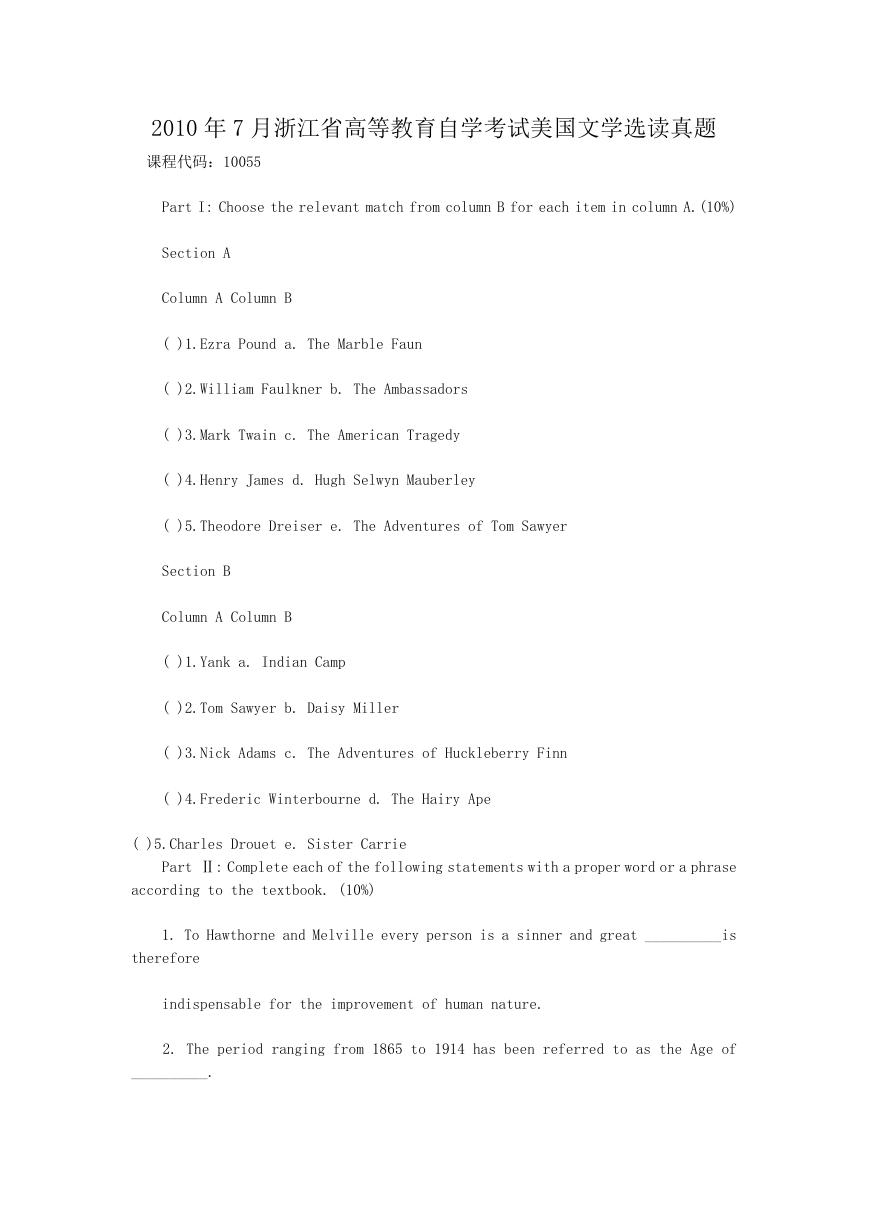

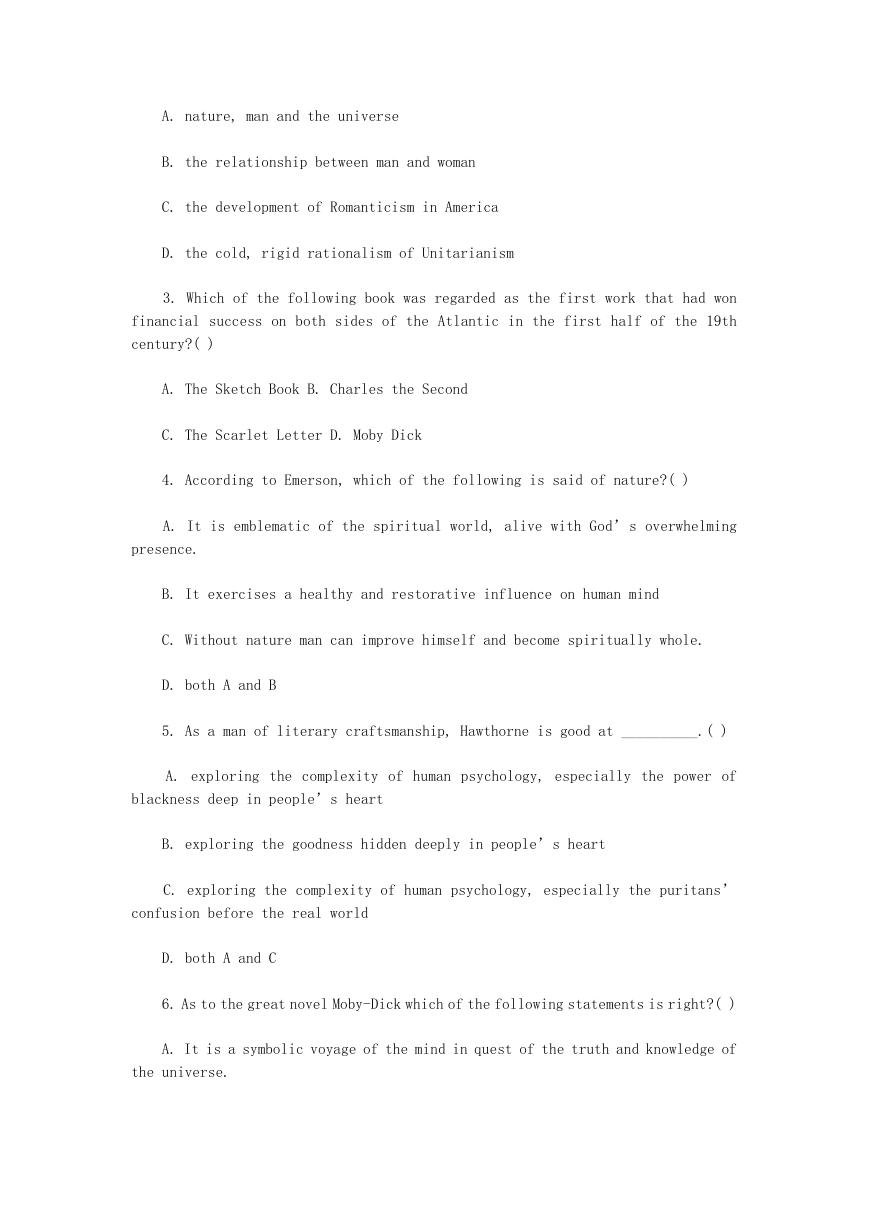
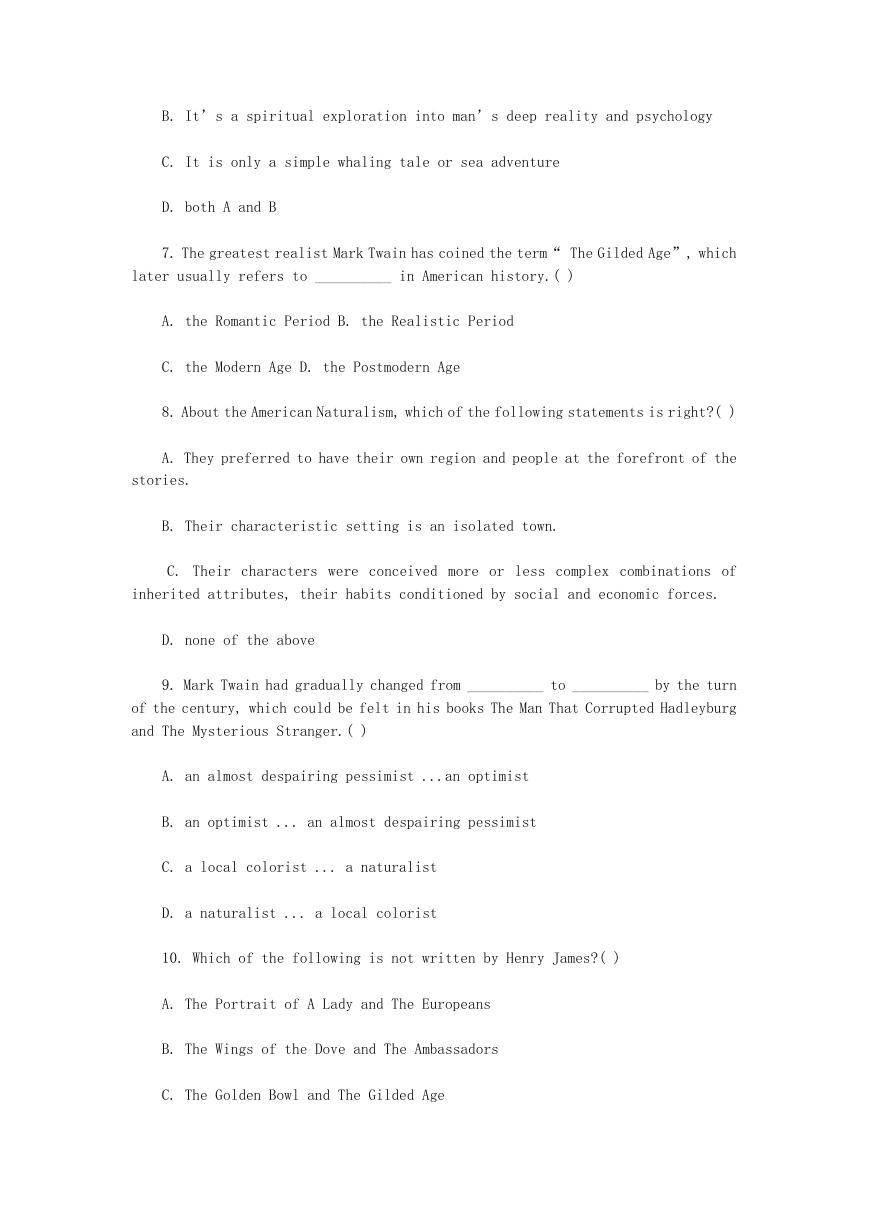
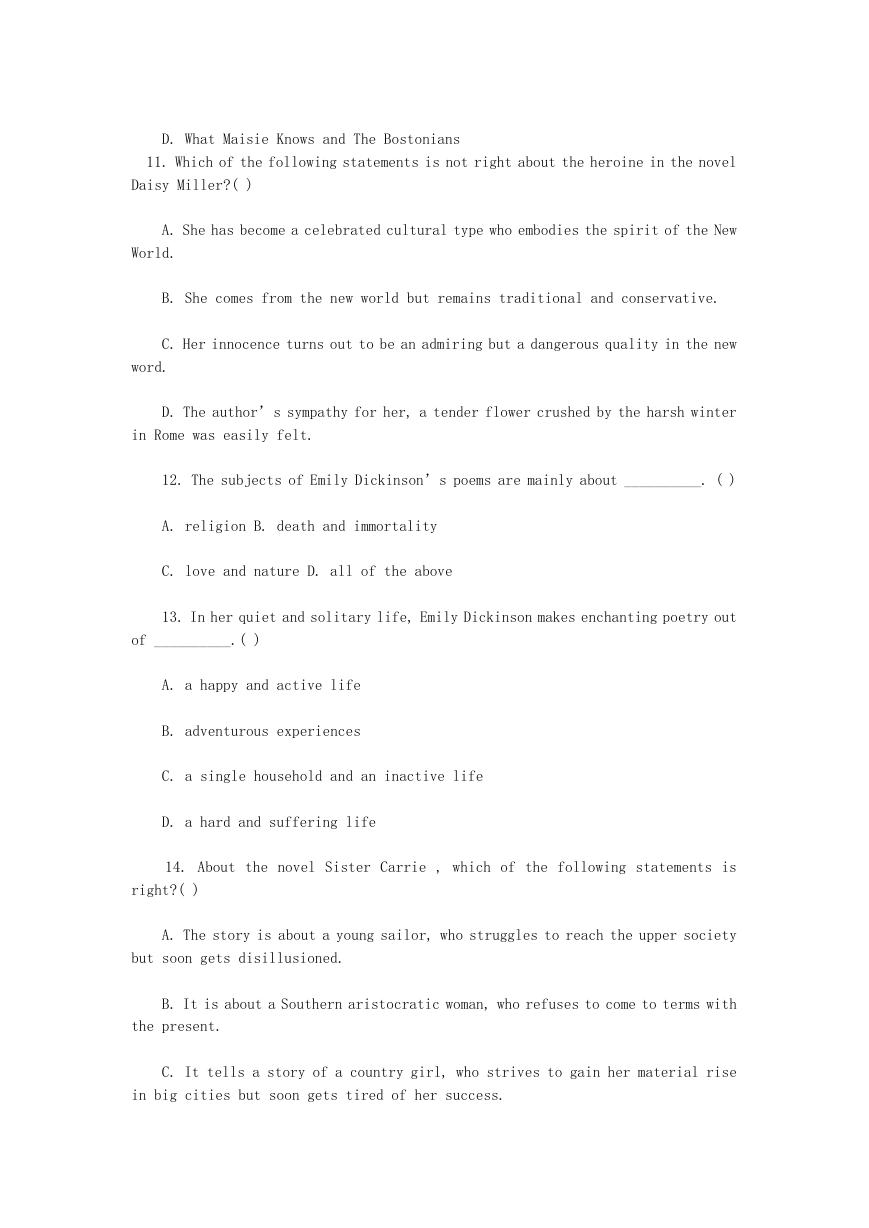
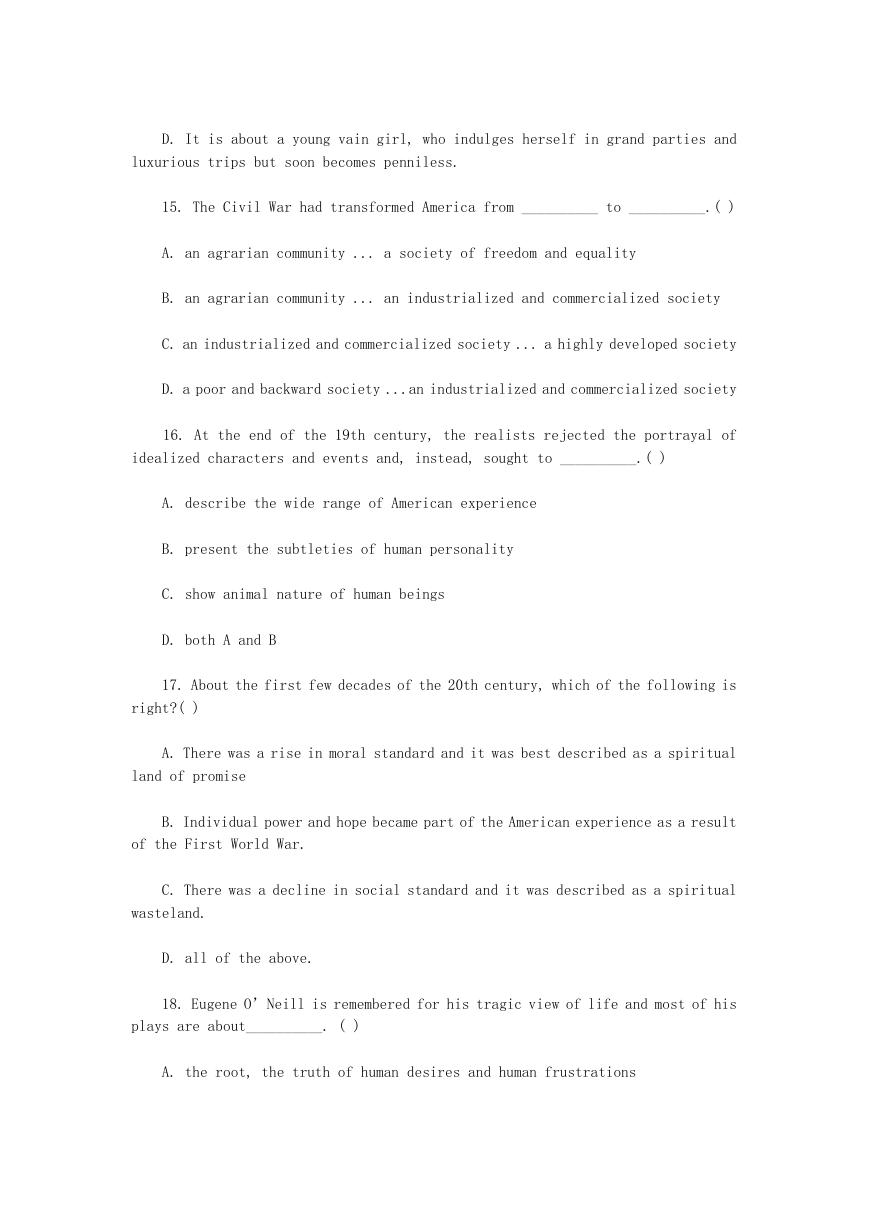
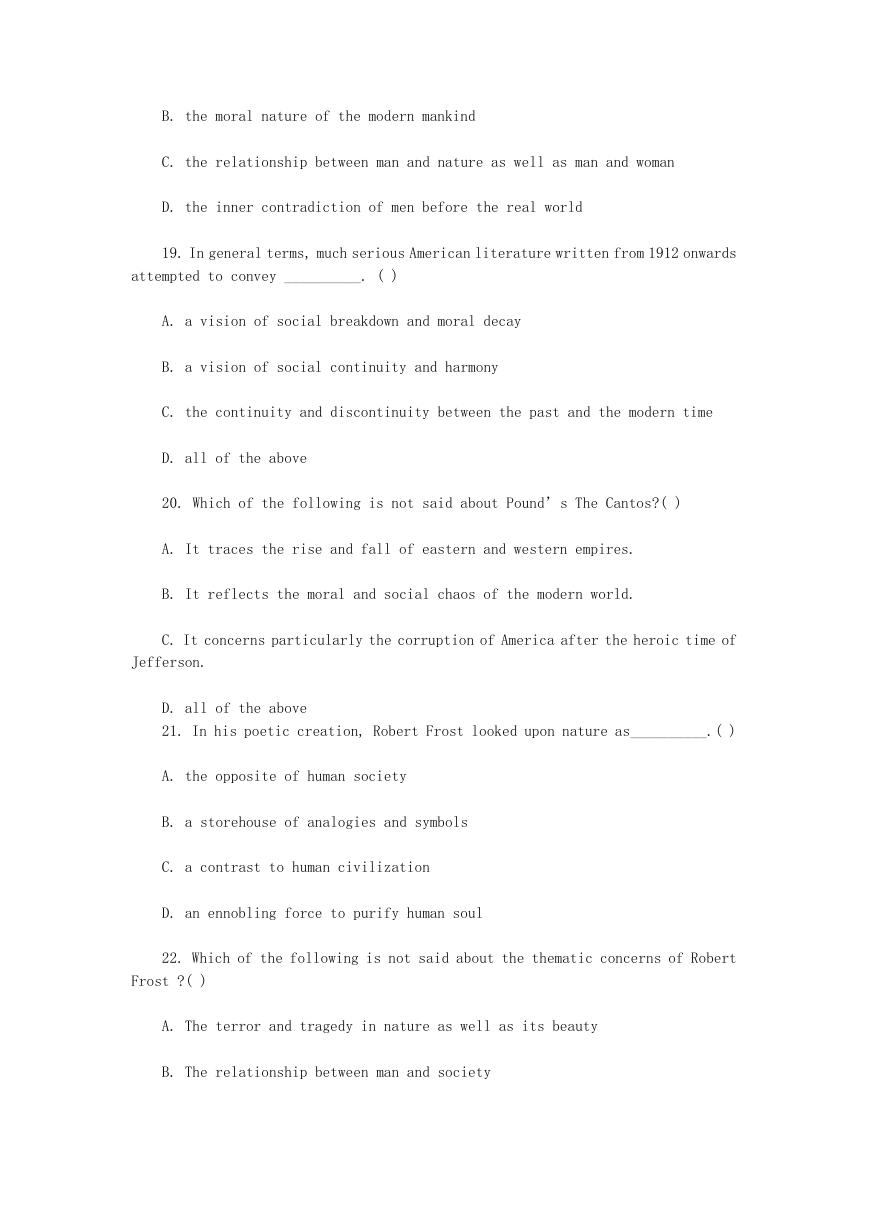
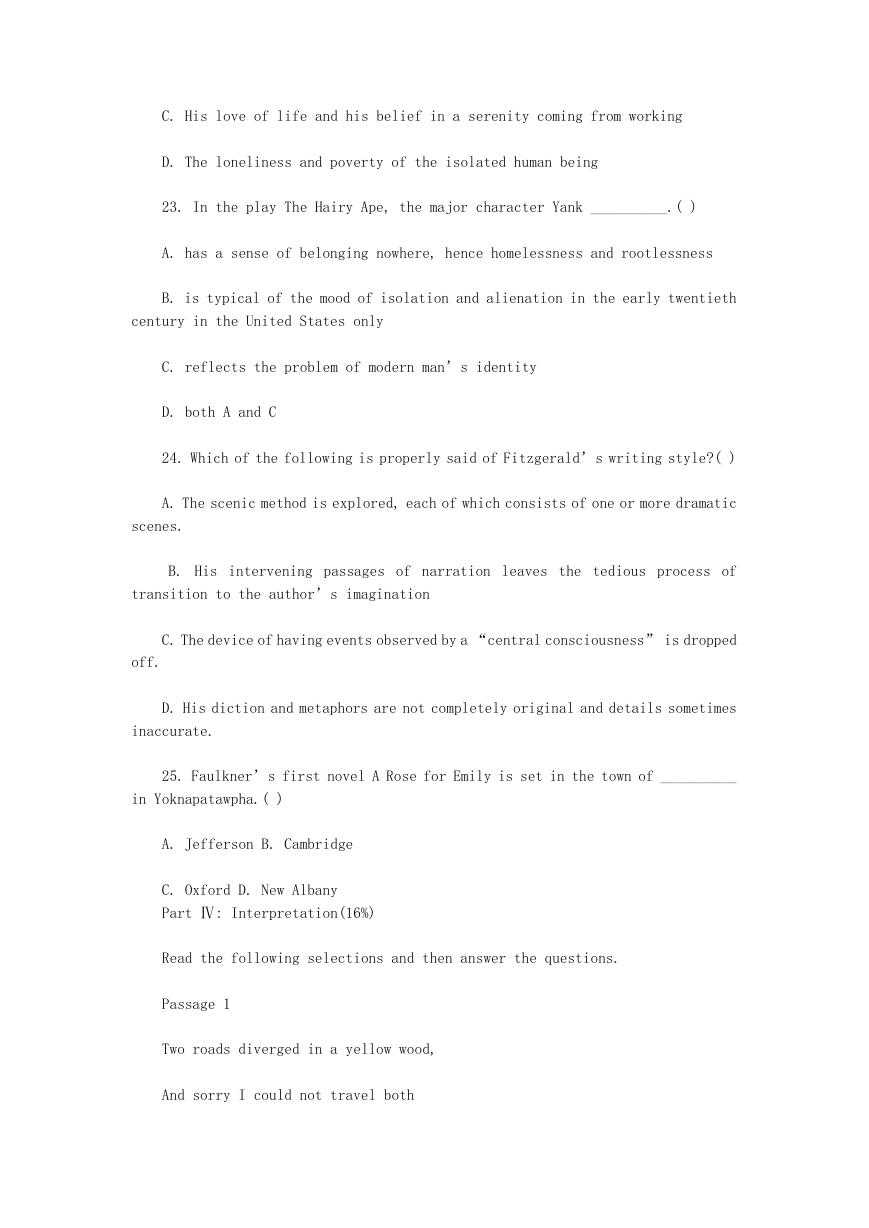








 2023年江西萍乡中考道德与法治真题及答案.doc
2023年江西萍乡中考道德与法治真题及答案.doc 2012年重庆南川中考生物真题及答案.doc
2012年重庆南川中考生物真题及答案.doc 2013年江西师范大学地理学综合及文艺理论基础考研真题.doc
2013年江西师范大学地理学综合及文艺理论基础考研真题.doc 2020年四川甘孜小升初语文真题及答案I卷.doc
2020年四川甘孜小升初语文真题及答案I卷.doc 2020年注册岩土工程师专业基础考试真题及答案.doc
2020年注册岩土工程师专业基础考试真题及答案.doc 2023-2024学年福建省厦门市九年级上学期数学月考试题及答案.doc
2023-2024学年福建省厦门市九年级上学期数学月考试题及答案.doc 2021-2022学年辽宁省沈阳市大东区九年级上学期语文期末试题及答案.doc
2021-2022学年辽宁省沈阳市大东区九年级上学期语文期末试题及答案.doc 2022-2023学年北京东城区初三第一学期物理期末试卷及答案.doc
2022-2023学年北京东城区初三第一学期物理期末试卷及答案.doc 2018上半年江西教师资格初中地理学科知识与教学能力真题及答案.doc
2018上半年江西教师资格初中地理学科知识与教学能力真题及答案.doc 2012年河北国家公务员申论考试真题及答案-省级.doc
2012年河北国家公务员申论考试真题及答案-省级.doc 2020-2021学年江苏省扬州市江都区邵樊片九年级上学期数学第一次质量检测试题及答案.doc
2020-2021学年江苏省扬州市江都区邵樊片九年级上学期数学第一次质量检测试题及答案.doc 2022下半年黑龙江教师资格证中学综合素质真题及答案.doc
2022下半年黑龙江教师资格证中学综合素质真题及答案.doc